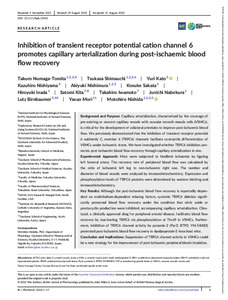Por favor, use este identificador para citar o enlazar este ítem:
https://repositorio.uca.edu.ar/handle/123456789/15358| Título: | Inhibition of transient receptor potential cation channel 6 promotes capillary arterialization during post-ischaemic blood flow recovery | Autor: | Numaga-Tomita, Takuro Shimauchi, Tsukasa Kato, Yuri Nishiyama, Kazuhiro Nishimura, Akiyuki Sakata, Kosuke Inada, Hiroyuki Kita, Satomi Iwamoto, Takahiro Nabekura, Junichi Birnbaumer, Lutz Mori, Yasuo Nishida, Motohiro |
Palabras clave: | TRPC6; ENFERMEDAD ATEROSCLEROTICA; RECEPTORES; CÉLULA MUSCULAR LISA VASCULAR; FOSFORILACIÓN | Fecha de publicación: | 2022 | Editorial: | Wiley | Cita: | Numaga-Tomita, T. et al. Inhibition of transient receptor potential cation channel 6 promotes capillary arterialization during post-ischaemic blood flow recovery [en línea]. British Journal of Pharmacology, 2022. doi: 10.1111/bph.15942. Disponible en: https://repositorio.uca.edu.ar/handle/123456789/15358 | Resumen: | Abstract: Background and Purpose: Capillary arterialization, characterized by the coverage of pre-existing or nascent capillary vessels with vascular smooth muscle cells (VSMCs), is critical for the development of collateral arterioles to improve post-ischaemic blood flow. We previously demonstrated that the inhibition of transient receptor potential 6 subfamily C, member 6 (TRPC6) channels facilitate contractile differentiation of VSMCs under ischaemic stress. We here investigated whether TRPC6 inhibition promotes post-ischaemic blood flow recovery through capillary arterialization in vivo. Experimental Approach: Mice were subjected to hindlimb ischaemia by ligating left femoral artery. The recovery rate of peripheral blood flow was calculated by the ratio of ischaemic left leg to non-ischaemic right one. The number and diameter of blood vessels were analysed by immunohistochemistry. Expression and phosphorylation levels of TRPC6 proteins were determined by western blotting and immunohistochemistry. Key Results: Although the post-ischaemic blood flow recovery is reportedly dependent on endothelium-dependent relaxing factors, systemic TRPC6 deletion significantly promoted blood flow recovery under the condition that nitric oxide or prostacyclin production were inhibited, accompanying capillary arterialization. Cilostazol, a clinically approved drug for peripheral arterial disease, facilitates blood flow recovery by inactivating TRPC6 via phosphorylation at Thr69 in VSMCs. Furthermore, inhibition of TRPC6 channel activity by pyrazole-2 (Pyr2; BTP2; YM-58483) promoted post-ischaemic blood flow recovery in Apolipoprotein E-knockout mice. Conclusion and Implications: Suppression of TRPC6 channel activity in VSMCs could be a new strategy for the improvement of post-ischaemic peripheral blood circulation. | URI: | https://repositorio.uca.edu.ar/handle/123456789/15358 | ISSN: | 0007-1188 (impreso) 1476-5381 (on line) |
Disciplina: | MEDICINA | DOI: | 10.1111/bph.15942 | Derechos: | Acceso abierto | Fuente: | British Journal of Pharmacology, 2022 |
| Aparece en las colecciones: | Artículos |
Ficheros en este ítem:
| Fichero | Descripción | Tamaño | Formato | |
|---|---|---|---|---|
| inhibition-transient-receptor-potential.pdf | 4,59 MB | Adobe PDF |  Visualizar/Abrir |
Visualizaciones de página(s)
58
comprobado en 27-abr-2024
Descarga(s)
116
comprobado en 27-abr-2024
Google ScholarTM
Ver en Google Scholar
Altmetric
Altmetric
Este ítem está sujeto a una Licencia Creative Commons

